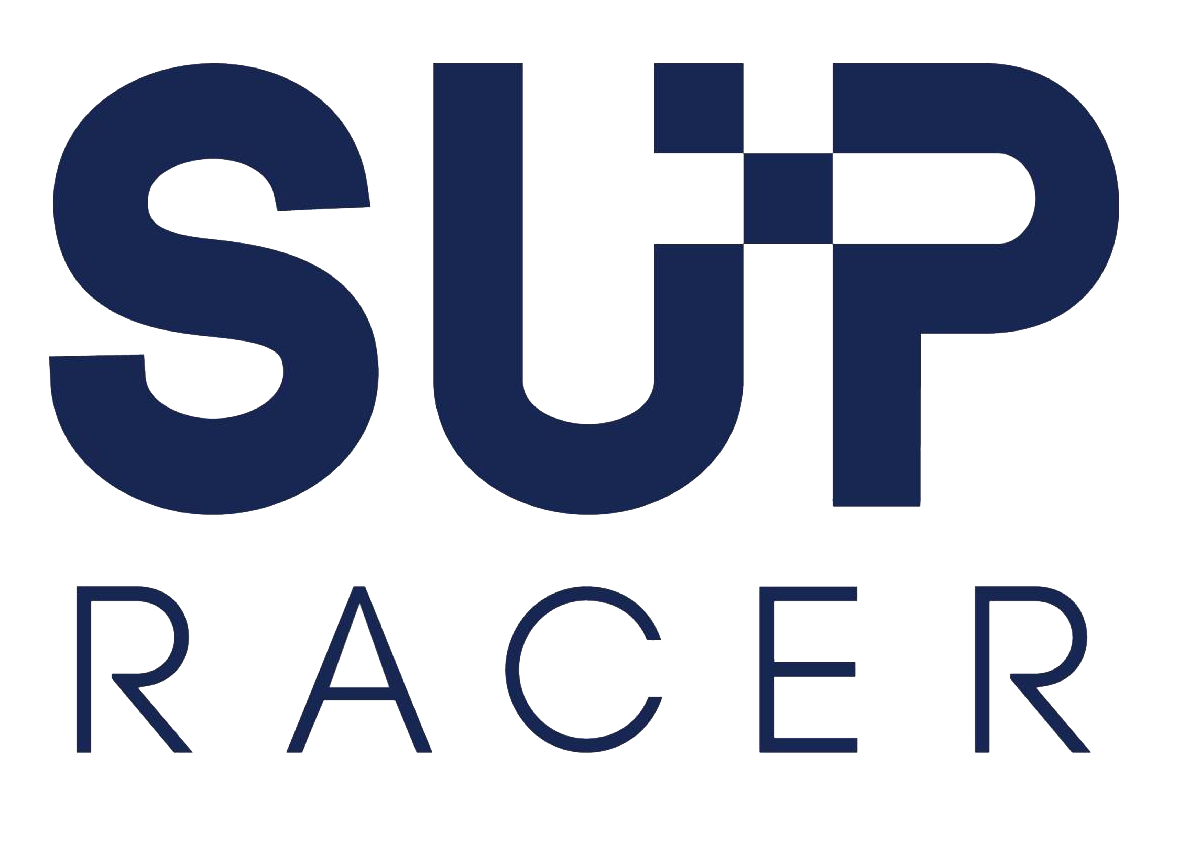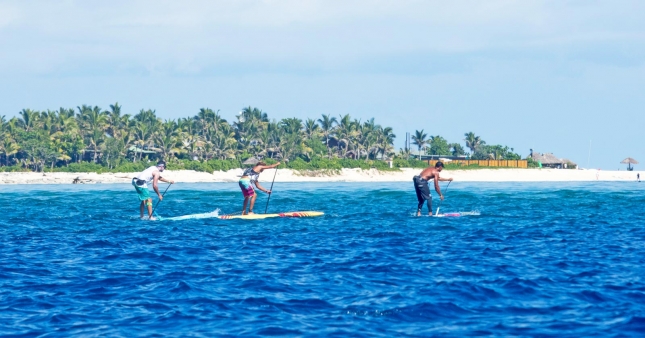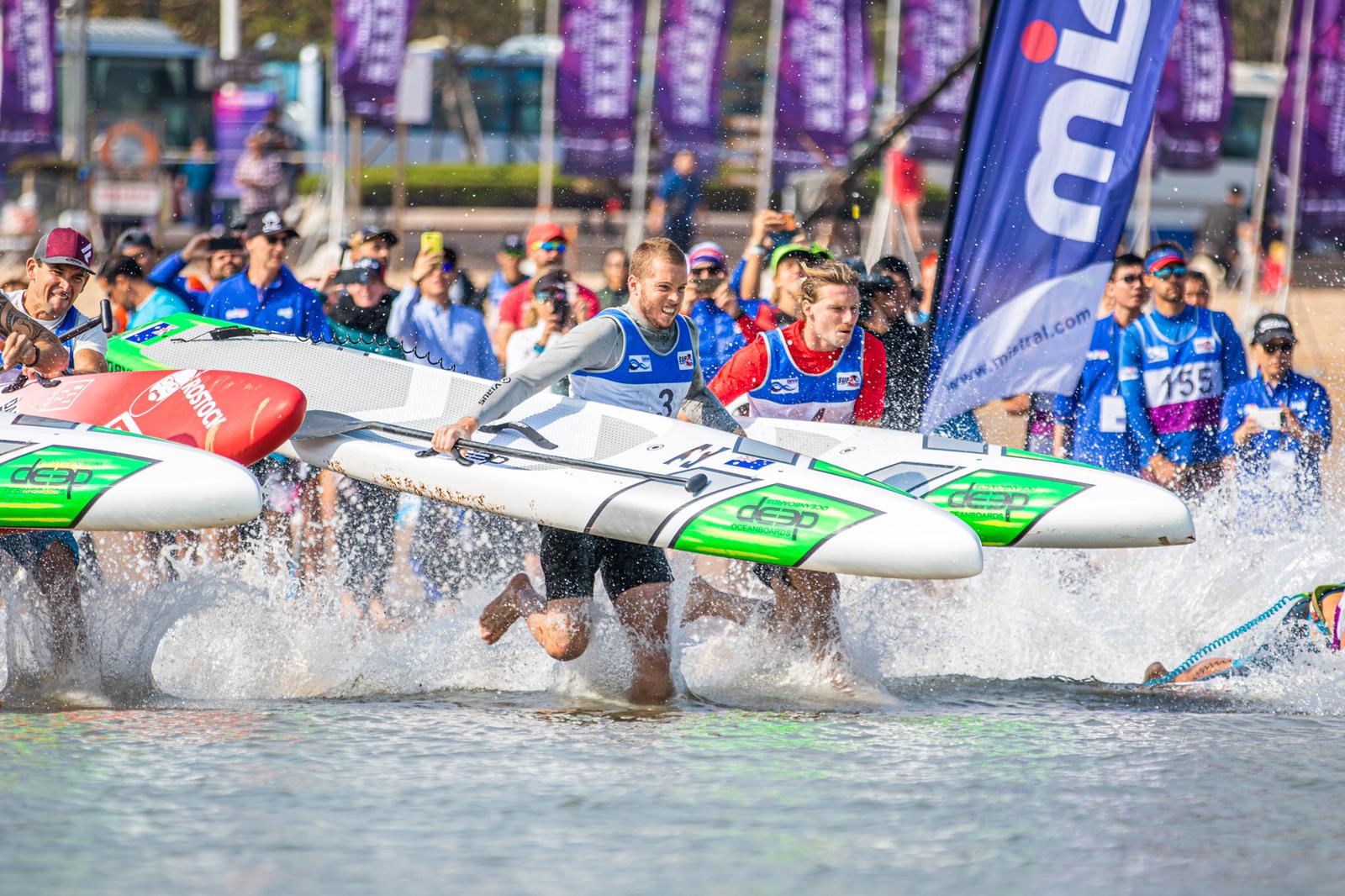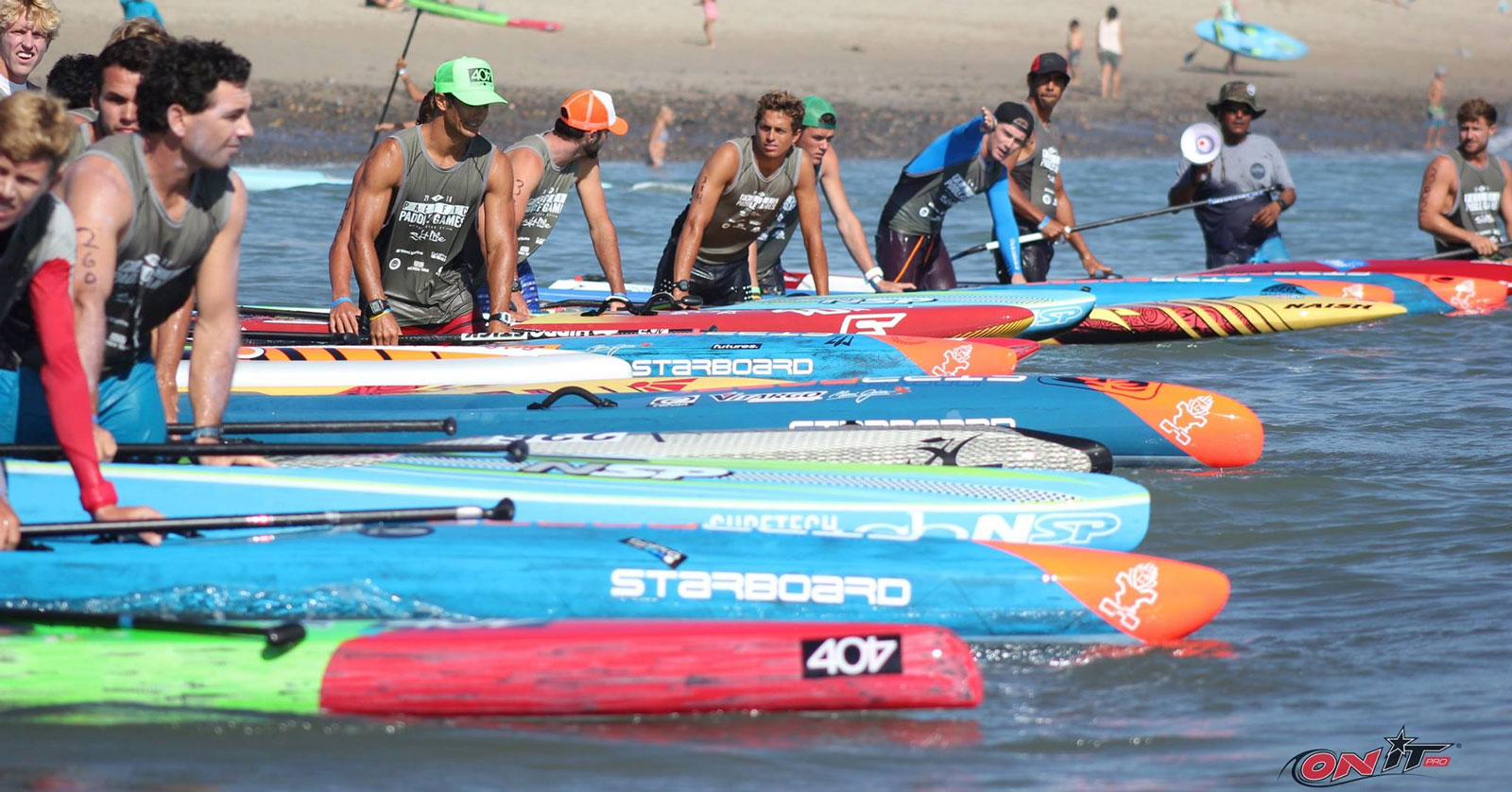
Race Board Stats: 14′ Dominates with 78% Market Share vs. 12’6 (Finally a Common Standard?)
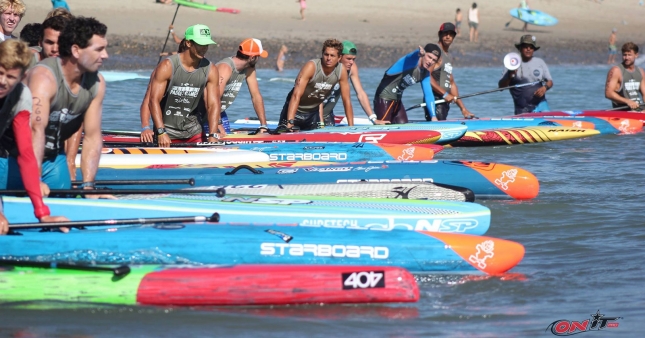
The elite men lined up at the Pacific Paddle Games (photo: OnIt Pro)
There’s been a very passionate (but rather boring) debate raging in the SUP racing community over the past few years, with various athletes, brands and event organisers arguing endlessly amongst themselves over a simple foot and a half of foam that’s almost indistinguishable to the casual observer.
To say I’m a little tired of the whole 12’6 vs 14′ board class debate would be an understatement – I think we should be discussing far more important topics such as how to grow grassroots participation and make elite races more exciting – but I was recently asked by a few big events to produce some stats on 12’6 vs 14, so here they are.
As you can see from the numbers below, 14′ boards thoroughly dominate the racing scene, with more than three quarters of men racing on 14 footers in a head-to-head comparison with 12’6. The biggest U.S. races (Carolina, the Gorge and the Pacific Paddle Games) along with the EuroTour and virtually every event in Australia all use 14′ as the standard (at least for men).
The stats are much more even in the women’s, largely due to America having that odd tradition of putting men and women on different boards (as opposed to Australia and Europe, where there’s gender equality and everyone paddles 14 footers).
Unlimited boards still exist and are a great part of the sport, however they’re only really present in the Hawaiian open ocean races (with a growing outpost in Australia’s downwind community); flat water unlimiteds are virtually extinct.
Note: The trend these days is to use the “Anything up to 14” board class, rather than setting 14′ in stone, which allows paddlers more freedom of choice.
Will these stats solve the board class debate once and for all? Probably not, but there’s clearly a strong shift towards 14 footers. Perhaps if the ISA finally showed some real leadership and announced Denmark as a 14′ event we would finally have a universal standard.
While the ISA Worlds is a relatively tiny event in terms of participation it does have a large trickle-down effect on the national federations. For example, in Australia virtually every race is on 14′ boards, however the Aussie national titles are still on 12’6 because of the ISA.
So why are we still using 12’6 at all? Most of the big races switched to 14′ long ago, and the old ‘travel argument’ (which said 12’6 boards were easier to get on planes) has been thoroughly debunked.
Some would say that 12’6 boards can handle the waves where 14 footers can’t, or that 12’6 races are more exciting than 14′ events. I’m all for creating more exciting racing – it should be one of our top priorities – but the two most exciting races of 2016 contradict that theory: The Pacific Paddle Games and the Jamie Mitchell Survivor Race were both 14′ races and were both held in the surf.
On the flipside, the ISA surf race in Fiji was on 12’6 boards and that was, with all due respect, one of the most boring races of the year. So “excitement” has almost nothing to do with board classes and almost everything to do with race courses and formats.
The only semi-valid argument I see is that many women prefer to race 12’6 boards. However I also know of several top ranked ladies who are pissed off they have to race on shorter boards when the men are on 14 footers — a couple of top athletes have told me they won’t be returning to Carolina until there’s gender equality.
Plus women’s elite race participation is less than a quarter compared to men (506 vs 1,762 or 22.3% vs 77.7%), so it would be odd to make a decision that suits the minority instead of the majority.
One final and seemingly-valid argument is that phasing out 12’6 boards would hurt an already-struggling industry, but clearly most paddlers are buying 14 footers already so that seems irrelevant. And besides, if you bought a 12’6 last year it’s going to be out of date next year anyway, so if you want to remain competitive you’re going to have to upgrade eventually no matter what. Plus if it’s “Anything up to 14” then your 12’6 is still perfectly legal; if it’s “12’6” then your 14 footer isn’t.
(One alternative solution, first proposed by Paul Jackson, is to make “Anything up to 12’6” the board class for juniors and “Anything up to 14” the standard for men and women. That seems reasonable – kids definitely don’t need the longer boards – however in the U.S. there’s already an 11′ junior board class, while in other parts of the world there’s a 10’6 standard for kids, so that could open up a whole new can of worms.)
(Another alternative: Have 14 footers for 99% of races, then introduce 10’6 boards as a specialty class for the short, sharp, exciting beach races that go down in the surf, seeing how 12’6 and 14 footers don’t handle waves too well. 10’6 would also be a logical standard for juniors across all racing. Sure, it might sound odd to suggest putting elite paddlers on 10’6 boards when we’re preaching 14ft as a standard, but there’s actually a growing movement to adopt this as a new race class for the specialty beach race events. Watch this space…)
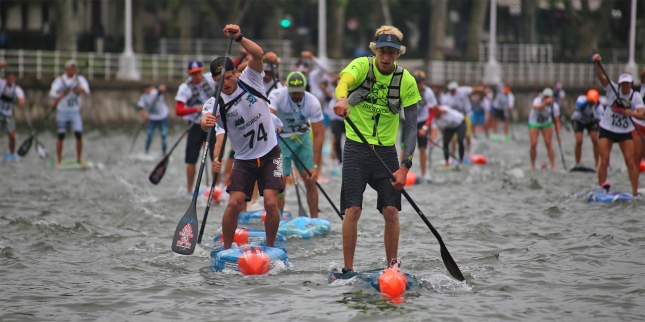
Connor Baxter leading the big race in Bilbao last year — Europe is now almost entirely 14′ thanks to the EuroTour (photo: Kerry Powell)
Does any of this even matter? Unfortunately it does…
I think having two different but fairly similar board classes is not only totally pointless but actually quite harmful to the sport. It creates fragmentation, frustration and confusion for athletes, event organisers, designers, brands, manufacturers, distributors, retailers and consumers (or in other words: Everyone).
No matter which way the sport goes, there will always be die-hards on either side of the fence – we’ll never please everyone – but I think it’d be easier if we all just agreed to have “Anything up to 14” as the universal standard. Then it would be rainbows and unicorns, and we could finally move on to discussing more important topics.
And all we really need is for the ISA to come out and say “Yeah let’s make Denmark a 14′ event just like all the other big races” and the debate would finally be over.
Apart from the ISA, the only other big 12’6 races are the Waterman League events, however they’ve become invite-only this year so that only really impacts two dozen sponsored athletes that mostly ride custom boards anyway (plus the Waterman League is considering abandoning 12’6 and moving down to 10’6 for the 2018 season).
But anyway, here are the stats. To me it seems like common sense to just embrace the “anything up to 14” standard, but you’re welcome to interpret these numbers however you like.
These stats are based on the elite divisions of the 30 international events listed in the 2016 Race Index.
| Board class | Total participation | Market share |
|---|---|---|
| Elite men 12'6 | 390 | 22.1% |
| Elite men 14' | 1,157 | 65.7% |
| Elite men unlimited | 215 | 12.2% |
If we take unlimited boards out of the picture (only 4 of the 30 races featured any unlimiteds), the head to head match up looks like this:
Elite race participation
Men 12’6 = 25.2%
Men 14ft = 74.8%
Another noteworthy stat: Out of the 10 “most elite” races of 2016, 7 were on 14 footers, 2 were on unlimiteds and only 1 was on 12’6.
These stats are only for elite participation — I think it’s even more important to look at the ‘open race’ participation to see what boards are actually being sold in retail stores; these open race events are the foundation of the sport.
While the data is incomplete, from what I’ve been able to piece together it seems that amateur paddlers are even more in favour of 14 footers than the pros: It’s more than four-fifths of men on 14 footers in the open divisions.
Open race participation
Open men 12’6: ~17%
Open men 14ft: ~83%
So when we combine elite and amateur participation the head-to-head match up looks like this:
Elite + open participation
Men’s 12’6 = 22%
Men’s 14ft = 78%
How about the ladies?
Considering the U.S. events have the tradition of putting men and women on different boards, and considering the States is far and away the biggest race market, you’d expect 12’6 to thoroughly dominate the elite women’s race scene. However it’s actually quite even in the end, thanks largely to the gender-equal systems in place in Europe and Australia.
| Board class | Total participation | Market share |
|---|---|---|
| Elite women 12'6 | 246 | 48.6% |
| Elite women 14' | 217 | 42.9% |
| Elite women unlimited | 43 | 8.5% |
TL;DR
Way more people race on 14′ than 12’6, so let’s just make “anything up to 14” the standard and move on to more important topics.
